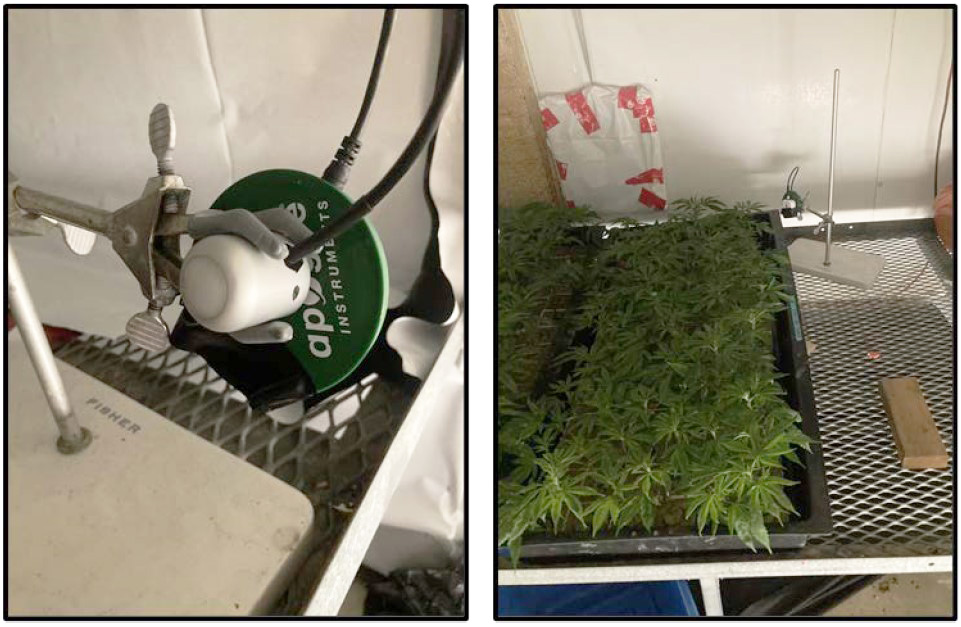Light Pollution for Cannabis Photoperiod
Utilizing the Apogee Quantum Light Pollution SQ-640 sensor in cannabis photoperiod research
David Llewellyn, Ashleigh Ahrens, Youbin Zheng*
School of Environmental Science, University of Guelph, Guelph, Ontario, Canada, N1G 2W1,
*yzheng@uoguelph.ca
Our main experimental objective was to investigate the critical photoperiod for inducing flowering in clones from different drug-type, indoor-grown cannabis cultivars. We used a 10 x 25 ft walk-in growth chamber that was divided into 6 individual compartments using moveable opaque vertical blinds and a central walkway. The floor is bare concrete and benches were made of expanded metal. Figure 1 shows the general setup of the compartments with benches, LED fixtures, and dividing curtains.

Figure 1. Walk-in growth chamber for conducting cannabis lighting research. Six compartments each have pairs of height-adjustable, dimmable LED fixtures (Jungle – LED G4i 1200, Allstate Garden Supply) and are divided by opaque blinds.
There was stray light pollution between individual compartments because of small light gaps between side curtains and reflection off the floor (through the mesh benches). Therefore, the first step for investigating cannabis’ photoperiod responses in this chamber was to determine the critical stray light pollution levels that could inhibit photoperiodic transitioning to flowering. This information would then guide the process of rigorously reducing and evaluating stray light pollution between compartments to appropriate levels.
The sensors used to evaluate stray light levels included quantum meters and a laboratory-grade spectroradiometer configured for horticultural research (the names of these instruments are intentionally withheld). Since these devices were designed to measure high light levels (e.g., full sun @ ≥ 2000 μmol∙m-2∙s-1), we found that they had difficulty to also accurately measure very low light levels (e.g., below 2 μmol∙m-2∙s-1). With careful attention and use of very long integration times, we could measure down to about 0.01 μmol∙m-2∙s-1 with acceptable accuracy (e.g., S:N >10) with the spectroradiometer, so this instrument was primarily used to evaluate the critical light pollution levels for inhibiting photoperiodic responses in cannabis.
Different sources indicate the range of minimum photon flux densities (PFDs) that can inhibit photoperiodic responses in various short-day crops (including cannabis) is from about 5 to 1 μmol∙m-2∙s-1. In a study that investigated stray light in the range of 20 to 0.02 μmol∙m-2∙s-1, we found that PFDs ≤ 0.1 μmol∙m-2∙s-1 (16-h photoperiod) could invoke measurable delays in the normal transition and development cannabis flowers under a 12-h photoperiod. Therefore, our threshold stray light level for the upcoming cannabis photoperiod trials was set at half this, ≤ 0.05 μmol∙m-2∙s-1.
As a side note: stray light from any direction can affect cannabis flowering, so stray light may be most appropriately measured with the sensor pointed directly at the major source of stray light (e.g., nearby curtain gaps). We believe that these measurements are more relevant for evaluating stray light than the up-facing sensor position that is normally used for crop PPFD characterizations.
The setup of the spectroradiometer was too cumbersome to be used effectively as a tool for evaluating chamber modifications to reduce stray light pollution levels below the 0.05 μmol∙m-2∙s-1 threshold and characterizing the final plot setups for the cannabis photoperiod experiments. This is where the Apogee SQ-640 Quantum Light Pollution sensor entered the picture, which was promoted as being able to resolve stray light levels as low as 0.002 μmol∙m-2∙s-1, with rapid response times. Preliminary testing showed good correlation between the SQ-640 and the other sensors at PFDs from 50 down to 0.1 μmol∙m-2∙s-1.
Henceforth, the SQ-640 was used to evaluate stray light pollution abatement strategies between compartments and to characterize the final stray light levels at plant canopy level around the entire perimeter of the experimental plots in every compartment (Figure 2). Characterizations were done with a given compartment’s lights turned off, but all other compartments were fully lit. All curtains were closed. The front curtain for the measured compartment was opened and closed between each reading to facilitate positioning of the sensor.

Figure 2. Using the Apogee SQ-640 Light Pollution Sensor and μCache Bluetooth Micro Logger (hidden behind green sensor base) on a retort stand to directionally-characterize stray light pollution in cannabis photoperiod treatment plots.
Prior to taking additional measures to block stray light between compartments, the stray PFD ranged from about 0.4 to 0.8 μmol∙m-2∙s-1. Improvements included covering the concrete floor under the compartments with matte black weed barrier and sealing off all curtain gaps (both above and below benches) with 6-mil panda-film (white side facing outwards). These steps reduced the average stray light PFD to 0.028 μmol∙m-2∙s-1 and the highest measured value at the perimeter of any plot was 0.072 μmol∙m-2∙s-1. Because we also found strong attenuation of stray light penetration into dense canopies, these stray light levels were considered acceptable for proceeding with the cannabis photoperiod experiments. Those experiments are ongoing, but preliminary results are exciting, and we look forward to sharing our results with the scientific community very soon.
Overall, in our experience, the SQ-640 was an extremely valuable instrument for conducting cannabis photoperiod research. The interface with the μCache Bluetooth Micro Logger and collection of data via the ApogeeConnect application on various mobile devices was relatively seamless. There were some minor hiccups with app permissions (e.g., to GPS) when initiating the application to connect to the sensor, on some mobile devices. While Bluetooth signals were very strong, these issues may have been exacerbated by conducting the work inside a growth chamber that had very poor connectivity to mobile and wireless networks.
